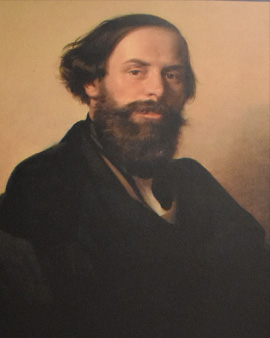Unfathomable is the look that Ippolito Caffi has painted in his self-portrait in the eyes. Open and yet thoughtful. The Venetian-born painter is attached to the epoch of realism and paints most of his works in the tradition of the younger artist Canaletto and Francesco Guardi. Vedute occupy the best known part of his surviving paintings: realistic representations of landscapes or cityscapes. The first surviving works of Ippolito Caffi date from his years of study at the "Accademia di Belle Arti", the art academy in Venice, from which he graduated in his early 20s.
After studying ancient Roman architecture, the budding painter was drawn to Rome, where artistic success slowly began to emerge for him. However, it did not last long for Caffi in the Eternal City. Whenever the professional opportunity to travel arose, he set off: to Trieste in northern Italy, Padua and Venice in Veneto, or to Lombardy, to Milan. Here Caffi continued to try to make a name for himself with exhibitions. However, it did not remain with Italy. From 1843 he was also drawn to faraway places: in Greece, Egypt, Turkey, Malta and Spain, the native of Belluno drew inspiration for later works on landscape and weather observations. In still preserved sketchbooks he recorded these thoughts and ideas.
In 1848 Ippolito Caffi exchanged an artist's brush for a soldier's weapons and fought in the Italian War of Independence against the Habsburgs, by whom he was also captured. After successfully escaping, he set out from Venice via Genoa and Switzerland to Turin in 1849. Several years would pass before Caffi's return to Rome, which he spent in London, Spain and Paris, among other places. In the French capital he also had a great success: At the World's Fair in 1855, he participated with a carnival scene of a piazzetta in Venice, which received great attention. The work was particularly praised for its extraordinary depiction of lighting conditions. The lighting effect in his vedute is Caffi's most outstanding quality feature. His main focus, however, was not to remain on peaceful architectural scenes. His intense patriotic activities among supporters of Garibaldi eventually led Caffi in the direction of war and battle painting. This sealed his fate: As a war painter, Ippolito Caffi boarded the ship Re d'Italia, which would carry him and his companions to their deaths in the naval battle of Lissa near Croatia in 1866. One of the most important vedutists in Veneto, Caffi also left behind the textbook "Lezioni di prospettiva practica", which was received with great interest among painting colleagues.
×





.jpg)
.jpg)
.jpg)
.jpg)
.jpg)
.jpg)
.jpg)
.jpg)
_Oil_on_canvas_31x44_cm_-_(MeisterDrucke-1092942).jpg)
_Oil_on_canvas_31x44_cm_-_(MeisterDrucke-1092942).jpg)
.jpg)
.jpg)
.jpg)
.jpg)
.jpg)
.jpg)
.jpg)
.jpg)
.jpg)
.jpg)
.jpg)
.jpg)
.jpg)
.jpg)
_oil_on_can_-_(MeisterDrucke-1089310).jpg)
_oil_on_can_-_(MeisterDrucke-1089310).jpg)
.jpg)
.jpg)
.jpg)
.jpg)
.jpg)
.jpg)
.jpg)
.jpg)
.jpg)
.jpg)
.jpg)
.jpg)
.jpg)
.jpg)
 - (MeisterDrucke-199887).jpg)
 - (MeisterDrucke-199887).jpg)
.jpg)
.jpg)
.jpg)
.jpg)
.jpg)
.jpg)
.jpg)
.jpg)
_-_(MeisterDrucke-1103295).jpg)
_-_(MeisterDrucke-1103295).jpg)
.jpg)
.jpg)
.jpg)
.jpg)
_-_(MeisterDrucke-1422997).jpg)
_-_(MeisterDrucke-1422997).jpg)
.jpg)
.jpg)
.jpg)
.jpg)
.jpg)
.jpg)
.jpg)
.jpg)
.jpg)
.jpg)
_-_(MeisterDrucke-1425228).jpg)
_-_(MeisterDrucke-1425228).jpg)
.jpg)
.jpg)
.jpg)
.jpg)
.jpg)
.jpg)
.jpg)
.jpg)
.jpg)
.jpg)
.jpg)
.jpg)
.jpg)
.jpg)
.jpg)
.jpg)
.jpg)
.jpg)
_Rome_Painting_by_Ippolito_Caffi_(1809-18_-_(MeisterDrucke-1035911).jpg)
_Rome_Painting_by_Ippolito_Caffi_(1809-18_-_(MeisterDrucke-1035911).jpg)
.jpg)
.jpg)
.jpg)
.jpg)
.jpg)
.jpg)
.jpg)
.jpg)
.jpg)
.jpg)
.jpg)
.jpg)
.jpg)
.jpg)
.jpg)
.jpg)
_-_(MeisterDrucke-1464958).jpg)
_-_(MeisterDrucke-1464958).jpg)
.jpg)
.jpg)
.jpg)
.jpg)
.jpg)
.jpg)






